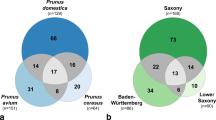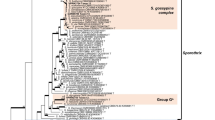Abstract
Diversity of fungi was investigated in Scots pine and Norway spruce stumps showing symptoms of butt rot in managed coniferous forests located in the northernmost distribution area of Heterobasidion butt rot in Finland. During a survey of 101 recently clear-cut stands, a total of 479 stumps showing signs of decay were sampled. Fungi were isolated from wood chips taken at the transition zone between healthy and decayed wood. A subsample of 209 isolates from Norway spruce and nine from Scots pine was selected for sequencing ITS-DNA. In Norway spruce 59 species and in Scots pine six fungal species were detected based on ≥98% similarity and 62 genera based on ≥95% similarity with sequences in GenBank. Three sequences did not match to any identified sequence in GenBank. The majority of the isolates (74%) were Ascomycota while 18% were Basidiomycota and 6% Zygomycota. The dominance of Ascomycota over Basidiomycota was pronounced in spruce stumps of stands with a butt rot incidence above 20% and the decayed area was larger in sample discs from which only Ascomycota were isolated than in discs inhabited by Basidiomycota. The result suggests that there is a high site- and/or tree -specific variation of the mycoflora in the Norway spruce decaying butt. Based on these results no single fungal species can be suspected to act as causal agent of butt rot occurring in Norway spruce nor in Scots pine in Northern Ostrobothnia and Kainuu counties.

Similar content being viewed by others
References
Filteau, M., Lagace, L., LaPointe, G., & Roy, D. (2012). Maple sap predominant microbial contaminants are correlated with the physicochemical and sensorial properties of maple syrup. International Journal of Food Microbiology, 154, 30–36.
Gardes, M., & Bruns, T. D. (1993). ITS primers with enhanced specificity for basidiomycetes - application to the identification of mycorrhizae and rusts. Molecular Ecology, 2, 113–118.
Giordano, L., Sillo, F., Guglielmo, F., & Gonthier, P. (2015). Comparing visual inspection of trees and molecular analysis of internal wood tissues for the diagnosis of wood decay fungi. Forestry, 88, 465–470.
Hallaksela, A.-M. (1984). Causal agents of butt-rot in Norway spruce in southern Finland. Silva Fennica, 18, 237–243.
Hallaksela, A.-M. (1993). Early interactions of Heterobasidion annosum and Stereum sanguinolentum with non-decay fungi and bacteria following inoculation into stems of Picea abies. European Journal of Forest Pathology, 23, 416–430.
Hansen, L., & Knudsen, H. (2000). Nordic macromycetes Vol. 1. Ascomycetes. Helsinki: Helsinki University Printing House.
Henttonen, H. M., Nöjd, P., & Mäkinen, H. (2017). Environment-induced growth changes in the Finnish forests during 1971 – 2000 – An analysis based on National Forest Inventory. Forest Ecology and Management, 386, 22–36.
Hesseltine, C. W., & Ellis, J. J. (1964). The genus Absidia: Gongronella and cylindrical-spored species of Absidia. Mycologia, 56, 568–601.
Holdenrieder, O., & Sieber, T. (1992). Fungal associations of serially washed healthy non-mycorrhizal roots pf Picea abies. Mycological Research, 96, 151–156.
Huse, K. J. (1981). The distribution of fungi in sound-looking stems of Picea abies in Norway. European Journal of Forest Pathology, 11, 1–6.
Kallio, T. (1971a). Protection of spruce stumps against Fomes annosus (Fr.) Cooke by some wood-inhabiting fungi. Acta Forestalia Fennica, (117), 1–20.
Kallio, T. (1971b). Aerial distribution of some wood-inhabiting fungi in Finland. Acta Forestalia Fennica, (115), 1–17.
Kärkkäinen, M. (1985). Puutiede. Hämeenlinna. Finland: Karisto Oy.
Kellomäki, S., Peltola, H., Nuutinen, T., Korhonen, K. T., & Strandman, H. (2008). Sensitivity of managed boreal forests in Finland to climate change, with implications for adaptive management. Philosophical Transactions of the Royal Society B., 363, 2341–2351.
Kotiranta, H., Saarenoksa, R., & Kytövuori, I. (2009). Aphyllophoroid fungi of Finland. A check-list with ecology, distribution and threat categories. Norrlinia, 19, 1–223.
Kubart, A., Vasaitis, R., Stenlid, J., & Dahlberg, A. (2016). Fungal communities in Norway spruce stumps along a latitudinal gradient in Sweden. Forest Ecology and Management, 371, 50–58.
Kubiak, K., Damszel, M., Sikora, K., Przemieniecki, S., Malecka, M., & Sierota, Z. (2017). Colonization of fungi and bacteria in stumps and roots of scots pine after thinning and treatment with Rotstop. Journal of Phytopathology, 165, 143–156.
Kuusisto, A. (2003). Ylläs-Aakennuksen alueen luonto. Metsähallituksen luonnonsuojelujulkaisuja, 141, 1–213.
Laine, L. (1976). The occurrence of Heterobasidion annosum (Fr.) Bref. In woody plants in Finland. Communicationes Instituti Forestalis Fenniae, 90, 1–53.
Linaldeddu, B. T., Franceschini, A., & Maranginu, P. (2003). Occurrence of fungal endophytes in healthy and declining plants of Pinus radiata. Journal of Plant Pathology, 85, 281–282.
Lindblad, I. (1998). Wood-inhabiting fungi on fallen logs of Norway spruce: Relations to forest management and substrate quality. Nordic Journal of Botany, 18(2), 243–255.
Lygis, V., Vasiliauskas, R., & Stenlid, J. (2004). Planting Betula pendula on pine sites infested by Heterobasidion annosum: Disease transfer, silvicultural evaluation, and community of wood-inhabiting fungi. Canadian Journal of Forest Research, 34, 120–130.
Lännenpää, A., Aakala, T., Kauhanen, H., & Kuuluvainen, T. (2008). Tree mortality agents in pristine Norway spruce forests in northern Fennoscandia. Silva Fennica, 42, 151–163.
Martinez, A., Cavello, I., Garmendia, G., Rufo, C., Cavalitto, S., & Vero, S. (2016). Yeasts from sub-Antarctic region: Biodiversity, enzymatic activities and their potential as oleaginous microorganisms. Extremophiles, 20, 759–769.
Müller, M. M., & Hallaksela, A.-M. (1998). Diversity of Norway spruce needle endophytes in various mixed and pure Norway spruce stands. Mycological Research, 102, 1183–1189.
Müller, M. M., & Hallaksela, A.-M. (2000). Fungal diversity in Norway spruce: A case study. Mycological Research, 104, 1139–1145.
Müller, M. M., Heinonen, J., & Korhonen, K. (2007). Occurrence of Heterobasidion basidiocarps on cull pieces of Norway spruce left on cutting areas and in mature spruce stands. Forest Pathology, 37, 374–386.
Müller, M. M., Henttonen, H. M., Penttilä, R., Kulju, M., Helo, T., & Kaitera, J. (2018a). Distribution of Heterobasidion butt rot in northern Finland. Forest Ecology and Management, 425, 85–91.
Müller, M. M., Kaitera, J., & Henttonen, H. M. (2018b). Butt rot incidence in the northernmost distribution area of Heterobasidion in Finland. Forest Ecology and Management, 425, 154–163.
Niemelä, T., & Dai, Y.-C. (1999). Polypores of Luosto. Metsähallituksen luonnonsuojelujulkaisuja., 105, 1–59.
Niemelä, T. (2005). Polypores, lignicolous fungi. Norrlinia, 13, 1–320.
Niemelä, T., Kinnunen, J., & Kotiranta, H. (2005). Pisavaaran luonnonpuiston ja Korouoman-Jäniskairan suojelualueen käävät. Metsähallituksen luonnonsuojelujulkaisuja, 150, 1–51.
Niemelä, T. (2016). Suomen käävät – The polypores of Finland. Norrlinia, 31, 1–430.
Norokorpi, Y. (1979). Old Norway spruce stands, amount of decay and decay-causing microbes in northern Finland. Communicationes Instituti Forestalis Fenniae, 97(6), 1–76.
Penttilä, R. (1994). Kainuun vanhojen metsien kääpälajisto. Metsähallituksen luonnonsuojelujulkaisuja, 35, 1–60.
Piri, T., Korhonen, K., & Sairanen, A. (1990). Occurrence of Heterobasidion annosum in pure and mixed spruce stands in southern Finland. Scandinavian Journal of Forest Research, 5, 113–125.
Rayner, A. D. M., & Boddy, L. (1988). Fungal decomposition of wood. Its biology and ecology (p. 587). New York: John Wiley & Sons.
Renvall, P., Renvall, T., & Niemelä, T. (1991). Basidiomycetes at the timberline in Lapland 2. An annotated checklist of the polypores of northeastern Finland. Karstenia, 31, 13–28.
Roll-Hansen, F., & Roll-Hansen, H. (1979a). Ascocoryne species in living stems of Picea species. A literature review. European Journal of Forest Pathology, 9, 275–280.
Roll-Hansen, F., & Roll-Hansen, H. (1979b). Microflora of sound-looking wood in Picea abies stems. European Journal of Forest Pathology, 9, 308–316.
Roll-Hansen, F., & Roll-Hansen, H. (1980a). Microorganisms which invade Picea abies in seasonal stem wounds. II. Ascomycetes, fungi imperfecti, and bacteria. General discussion, Hymenomycetes included. European Journal of Forest Pathology, 10, 396–410.
Roll-Hansen, F., & Roll-Hansen, H. (1980b). Mircroorganisms which invade Picea abies in seasonal stem wounds. I. General aspects, Hymenomycetes. European Journal of Forest Pathology, 10, 321–339.
Ryman, S., & Holmåsen, I. (1987). Suomen ja pohjolan sienet. In Porvoo – Helsinki – Juva: WSOY.
Salo, P., Niemelä, T., & Salo, U. (2006). Suomen Sieniopas. Werner Söderström Osakeyhtiö (p. 512). Finland: Helsinki.
Sampaio, J. P., Golubev, W. I., Fell, J. W., Gadanho, M., & Golubev, N. W. (2004). Curvibasidium cygneicollum gen. Nov., sp. nov. and Curbibasidium pallidicorallinum sp. nov., novel taxa in the Microbotryomycetidae (Urediniomycetes), and their relationship with Rhodotorula fujisanensis and Rhodotorula nothofagi. International Journal of Systematic and Evolutionary Microbiology, 54, 1401–1407.
Sippola, A.-L., & Renvall, P. (1999). Wood-decomposing fungi and seed-tree cutting: A 40-year perspective. Forest Ecology and Management, 115, 183–201.
Solheim, H. (2006). White rot fungi in living Norway spruce trees at high elevation in southern Norway with notes on gross characteristics of the rot. Aktuelt fra Skogforskning, 1, 5–12.
Taigø, V., Chastagner, G., Thomsen, I. M., Cech, T., Riley, K., Lange, K., Klensdahl, S. S., & Stensvand, A. (2010). Sydowia polyspora associated with current season needle necrosis (CSNN) on true fir (Abies spp.). Fungal Biology, 114, 545–554.
Toivanen, T., Markkanen, A., Kotiaho, J. S., & Halme, P. (2012). The effect of forest fuel harvesting on the fungal diversity of clear-cuts. Biomass and Bioenergy, 39, 84–93.
Uotila, A. (1990). Infection of pruning wounds in Scots pine by Phacidium coniferarum and selection of pruning season. Acta Forestalia Fennica, (215), 1–36.
Vainio, E. J., Korhonen, K., & Hantula, J. (1998). Genetic variation in Phlebiopsis gigantea as detected with random amplified microsatellite (RAMS) markers. Mycological Research, 102, 187–192.
Vasaitis, R., Burnevica, N., Uotila, A., Dahlberg, A., & Kasanen, R. (2016). Cut Picea abies stumps constitute low quality substrate for sustaining biodiversity in fungal communities. Baltic Forestry, 22(2), 239–245.
Vasiliauskas, R., & Stenlid, J. (1998). Fungi inhabiting stems of Picea abies in a managed stand in Lithuania. Forest Ecology and Management, 109, 119–126.
Vasiliauskas, R., Larsson, E., Larsson, K.-H., & Stenlid, J. (2005). Persistence and long term impact of Rotstop biological control agent on mycodiversity in Picea abies stumps. Biological Control, 32, 295–304.
White, T. J., Bruns, T., Lee, S., & Taylor, J. W. (1990). Amplification and direct sequencing of fungal ribosomal RNA genes for phylogenetics. Pp. 315–322 in: PCR protocols: A guide to methods and applications, eds. Innis, M. A., D. H. Gelfand, J. J. Sninsky, and T. J. White. New York: Academic Press.
Woodward, S., Karjalainen, R., & Hüttermann, A. (1998). Heterobasidion annosum, biology, ecology, impact and control (p. 589). Wallingford, UK: CAB International.
Yurkov, A., Inácio, J., Chernov, I. Y., & Fonseca, Á. (2015). Yeast biogeography and the effects of species recognition approaches: The case study of widespread basidiomycetous species from birch forests in Russia. Current Microbiology, 70, 587–601.
Zhang, F., Wang, Z.-P., Chi, Z., Raoufi, Z., Abdollahi, S., & Chi, Z.-M. (2013). The changes in Tps1 activity, trehalose content and expression of TPS1 gene in the psychrotolerant yeast Guehomyces pullulans 17-1 grown at different temperatures. Extremophiles, 17, 241–249.
Acknowledgements
We thank Timo Mikkonen and Ulla Repo for helping in treatments and measurements of the wood discs and chips, and isolation and cultivation of the fungi in the laboratory. Seppo Pohjola, Kalervo Kylmänen, Jorma Pasanen, Heikki Vesala and Osmo Murtovaara are acknowledged for the field inventory and collection of wood discs. We are grateful to Dr. Kiti Müller for valuable comments on the manuscript.
Author information
Authors and Affiliations
Corresponding author
Ethics declarations
The authors bear all the ethical responsibilities of this manuscript. They declare that the research was conducted in the absence of any commercial or financial relationships that could be construed as a potential conflict of interest and that it does not include any animal and/or human trials.
Rights and permissions
About this article
Cite this article
Kaitera, J., Henttonen, H.M. & Müller, M.M. Fungal species associated with butt rot of mature Scots pine and Norway spruce in northern boreal forests of Northern Ostrobothnia and Kainuu in Finland. Eur J Plant Pathol 154, 541–554 (2019). https://doi.org/10.1007/s10658-019-01678-2
Accepted:
Published:
Issue Date:
DOI: https://doi.org/10.1007/s10658-019-01678-2




